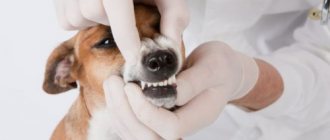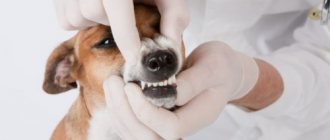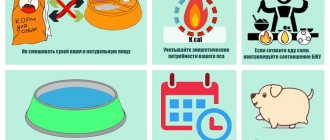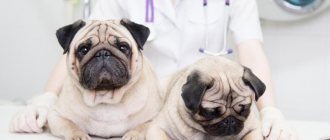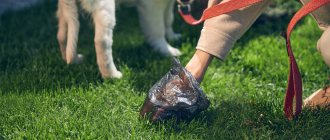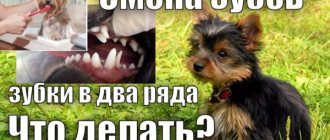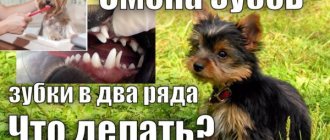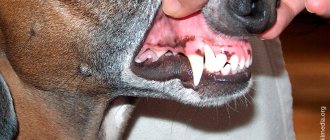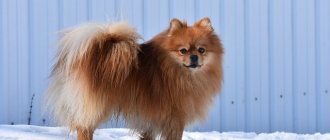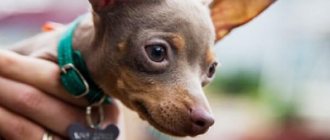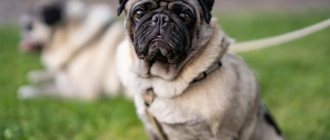Full health of a dog means the good condition of all its organs and systems, including teeth. Unfortunately, these friendly animals, which have served man faithfully for a long time, have not been spared many “human” diseases. One of them is an incorrect bite in a dog.
For breeding puppies or service breed dogs, this disease becomes a death sentence, excluding the right to serve or breed. In addition, this deficiency greatly affects the dog’s overall health.
Consequences of malocclusion for a dog's health
The chewing apparatus is the beginning of the gastrointestinal tract. Therefore, disturbances in its structure inevitably affect the functioning of the digestive system:
- difficulty in eating and chewing food causes gastrointestinal disorders;
- severe malocclusion can cause oral injuries;
- loose jaw closure leads to constant drooling, which means the appearance of weeping eczema and dermatitis.
At the same time, if minor deviations from the norm do not worsen the quality of life of the animals, then correcting the bite in dogs may not be necessary.
In any case, the final decision on further actions must be made by a veterinarian orthodontist.
Owner actions
A responsible owner must understand that a corrected bite in a pet does not mean that no matter how good its exterior is, this representative can participate in breeding. A female or male will definitely pass this defect on to her offspring.
After getting braces, your dog needs to be treated daily so that food does not accumulate under the steel mechanism, irritating the gums. The mandatory cleaning ritual takes little time, the animal quickly gets used to it and the teeth remain healthy.
.
a special collar on him.
. The collar is not removed until the dog stops paying attention to the braces.
Types of bite
Let's consider what types of bites exist (from normal to pathological) and what evil can be expected from the incorrect arrangement of teeth.
The main functions of dog teeth are:
- Capturing prey. It is carried out by fangs and incisors. Four fangs (2 on each jaw) have an elongated, slightly curved shape. Between them there are smaller incisors.
- Chewing food. This task is performed by molars (premolars and molars). They are located at the back, behind the fangs.
Normal bite
Normal bite (orthognathia) is also called scissor bite. When the mouth is closed, the lower incisors should press closely against the back of the upper incisors. A scissor bite ensures normal chewing of food, protects the soft tissues of the oral cavity from traumatic disorders, and ensures normal retention of prey.
Purebred dogs that have deviations from this form of jaw closure are always mercilessly disqualified and not allowed for breeding. The reason for this strictness is that bite defects often begin to form as a result of genetic disorders. This pathology can be inherited.
Pathological bite
There are several options for pathological bite:
- A straight (pincer) bite is sometimes considered a normal variant. The incisors of the lower and upper jaws touch with their cutting edges. In this position, these teeth are subject to a large load for which they are not designed. The disadvantage of this bite is the rapid grinding of the incisors. The remaining teeth are not affected.
- Undershot (prognathia). A shortened lower jaw causes the incisors to not touch each other. Canines, premolars and molars take on the entire load, which leads to their rapid wear. Undershot is considered a disqualifying characteristic for all dog breeds without exception.
- Snack (progenia). The peculiarity of the structure of the muzzle is such that the lower jaw protrudes far forward, opening the incisors. Bulldogs and boxers have this skull structure. Therefore, for dogs of these breeds, snacking is not a defect.
- Asymmetrical bite. Formed when one side of the jaw is more developed than the other. May be a common cause of health problems. This is a disqualifying sign that applies to all breeds of dogs.
- Open bite. It is formed due to improper growth of the incisors, which do not close at all when the jaws are closed.
Video. Showing Teeth - Puppy Training
Recently, more and more dog owners have been turning to the issue of dental pathology in dogs, since dental diseases in pets very often cause chronic damage to the stomach, intestines, skin, joints, kidneys, respiratory organs and even the heart. It is known that the state of an animal’s digestive system affects both the overall well-being of the animal and its economically useful qualities.
Malocclusion in dogs is one of the most common oral pathologies. It makes it difficult to both eat and chew food. In addition, incorrect location and shape of teeth injure the mucous membrane of the gums, cheeks, tongue and lips and can cause sinusitis. Dogs with malocclusions do not participate in exhibitions, and even successful correction of the bite in such animals does not allow them to take part in breeding work, because Any pathology of the jaws is often genetic in nature.
The reasons for the development of malocclusion can be:
Hereditary, genetic abnormalities; — developmental disorder; - games and training with improper load on growing teeth; - lack of minerals in the diet; - injuries; - untimely change of teeth; - discrepancy between the size of the teeth and the size of the jaws, too large molars.
Orthodontics is a branch of veterinary dentistry that deals with the correction and prevention of malocclusions. At the moment, a veterinary dentist has a large number of devices for correcting bites in both puppies and adults. The sooner bite correction in dogs occurs, the easier and faster it is possible to achieve good results. With age, the compaction of the jaw bones leads to a significant slowdown in bone remodeling processes. Braces are special designs for straightening teeth and correcting bites.
Puppies are born completely toothless. At 3-4 weeks from birth, their baby teeth begin to erupt. The first to appear are the incisors (4 – 6 weeks), then the canines (3 – 5 weeks) and premolars (5 – 6 weeks). The total number of milk teeth is 28; after a change of teeth, the normal dental formula of a dog is already 42 teeth; moreover, these teeth differ not only in number, but also in size. They are much larger than their dairy predecessors. But sometimes some animals have incomplete teeth (oligodontia) or the presence of extra teeth (polyodontia, hyperdontia).
The replacement of baby teeth and the eruption of permanent teeth begins at the 4th month in the following order: from 3 to 5 months the incisors change, from 4 to 7 months the canines change. The first premolar first grows from the molars (at 4-6 months) and is not replaced (that is, it has no milk analogue), then three molars grow and also remain forever (5-7 months). Thus, by seven months the change of teeth should be completely completed.
In small decorative dog breeds, false polyodontia (non-loss of milk teeth, double row of teeth) is often observed. The main reasons for this phenomenon: - insufficient development of chewing muscles, - insufficient resorption of the roots of baby teeth, - reduction in the size of the jaws and gums with teeth practically unchanged in shape, - diet errors (soft and liquid food, lack of calcium in the diet).
BITE ANOMALIES
Prognathia (underbite) is the insufficient development of the lower jaw when its incisors do not reach the upper ones. There may be a gap between the upper and lower incisors when the mouth is closed. The upper premolars are displaced at least twenty-five percent anterior to the lower premolars. This malocclusion is not considered normal in any breed.
Progenia (overbite, bulldog bite, reverse scissor bite) occurs when the lower incisors protrude in front of the upper incisors. In some short-faced breeds (boxers, English and French bulldogs, Shih Tzu), this type of bite is considered normal. When the edges of the upper and lower incisors touch each other, the occlusion is called “direct bite.” Constant contact between the upper and lower incisors can cause uneven wear, periodontal disease, and early tooth loss. A straight bite is considered normal in some breeds, although it is actually a variant of progeny.
An anterior crossbite occurs when the canines and premolars on both sides meet normally, but one or more of the lower incisors are positioned in front of the upper incisors. This dental position may be caused by games of tug of war, retention of baby teeth, and is not considered a genetic or hereditary defect.
A crooked mouth, or crooked bite, occurs when one side of the jaw grows faster than the other. A crooked bite is a severe hereditary defect. Internal displacement of the canine teeth occurs when the lower canine teeth point inward and often cause damage to the upper palate. This position occurs either due to retained baby teeth or due to an excessively narrow lower jaw.
An open bite in dogs occurs when some of the incisors are spaced vertically apart and do not touch each other. In this case, the animal’s tongue often hangs out.
Unerupted teeth remaining in the jaw after the time of their eruption are called impacted. This can be confirmed after a clinical examination and x-rays of the jaws. Deep-lying teeth can remain in the jaw for a long time. If they do not put pressure on neighboring teeth, do not cause their resorption or migration, or cause pain, there is no point in attempting to erupt and place them in the dentition.
All types of devices for correcting bites can be divided into removable and non-removable (braces).
The latest advancement in veterinary orthodontics, clear, removable aligners (invisible braces) were originally developed for humans. Their main advantage for animals is a one-time anesthesia for the doctor to take accurate impressions of the jaw. The ability to remove the aligners during meals and for hygiene procedures is also a significant convenience of this new technique.
Invisible mouth guards, made of acrylic, fit closely to the dog's teeth and press them in the desired direction. Once every one or two weeks, the aligners are replaced with others that differ by 1-2 mm, thus gradually moving the teeth in the desired direction. The laboratory prepares a series of sequential impressions to move the teeth in small increments.
The dog should wear the mouth guard for as many hours a day as possible. Pet owners should wash and brush these removable acrylic braces with toothpaste every day. In veterinary practice, the use of removable acrylic braces is still very limited, due to the high cost of this technology. More often, modified removable braces in the form of a rubber ring are used, which gives good results in small puppies.
Fixed structures are fixed for the entire period of bite correction. In this case, the orthodontist periodically tightens the plates, adjusting the degree of inclination and rotation of the tooth being corrected. Thus, by changing the pressure on individual teeth and the dentition as a whole, it is possible to quickly correct the bite.
A brace (from English - bracket) is a complex orthodontic device consisting of clasps and wires. Locks or braces are fixed to the teeth using a special glue. The wire can be of different shapes and, depending on this, exerts different pressures to solve specific orthodontic problems. The wire can be changed. The thicker its diameter, the greater the pressure exerted on the molars.
The key to success when using braces is following the rules of caring for them, avoiding mechanical damage when playing, avoiding solid foods and bones. Contraindications for installing braces include allergies, periodontitis, neoplasms, and ulcerative stomatitis.
Effective management of orthodontic problems in dogs involves making the correct diagnosis, determining the optimal treatment method (with a minimum amount of anesthesia) and advising owners about the possibility of their animal participating in breeding.
Occlusion is the position of the lower incisors relative to the upper ones. Correct - the upper jaw extends 1-2 mm forward above the lower jaw. Malocclusion in dogs is when the lower jaw is longer or shorter, which means it comes forward or remains at a considerable distance behind.
Malocclusion can be a defect for some breeds, and be the norm for others.
There is no one general norm for all breeds. For different breeds of dogs, different positions of the front teeth are considered standard. Hence another position - that for one breed it is a defect, for another it is a standard. Animals with malocclusion are not allowed to develop the breed. The defect is transmitted genetically and can appear after several generations. This situation is dangerous for maintaining the purity of the breed.
Veterinarians name several points that affect the correct bite.
If we ignore genetics, malocclusion develops in childhood. The position of teeth in adult animals depends on care - food, load on the jaws and teeth. Dog handlers monitor the development of teeth and consult with veterinarians at the slightest irregularities.
Puppies are characterized by a floating jaw position. This is due to bone growth. At 1.5 months, the teeth are finally formed.
Jaw abnormalities are affected by:
- improper metabolism;
- untimely replacement of baby teeth;
- jaw box injuries;
It is impossible to detect malocclusion in a puppy that is not yet 4 months old.
Important! It is impossible to detect malocclusion in an animal under 4 months of age.
Metabolic disorders
Lack of calcium and vitamin D leads to problems with teeth and jawbone. A growing body must receive the amount of vitamins and microelements required for the breed. If this process is not controlled, and with it an incorrect bite, the pet is guaranteed to suffer.
Untimely replacement of baby teeth
Untimely replacement of baby teeth leads to the fact that permanent teeth begin to grow on top of children's teeth. This leads to deformation and incorrect position. At the same time, the jaw remains correct. The bite is disturbed, the teeth become crooked. To prevent this from happening, take care of your baby teeth. As soon as the gums become inflamed and there are prerequisites for the appearance of permanent teeth, the milk teeth are removed if they have not fallen out on their own by this time.
Jaw box injuries
This situation is typical for mobile and active puppies. Games and chewing brains lead to injuries. Babies require close supervision. , furniture, household utensils. This habit is harmful not only to the home, but also to the health of the animal. The dentition is damaged and the jaw is injured. The result is an incorrect bite.
An incorrect bite can form due to trauma to the jaw suffered by the puppy during the change of teeth.
This situation is not very common for adult dogs. They are more careful. The cause of injury in an adult animal can be a blow to the head or jaw with a blunt object. Depending on the force of the blow and the degree of injury, there may be consequences for the dog. In some cases, the veterinarian cannot help the animal.
Many owners play tug of war without calculating their strength. The puppy's fragile jaw and weak teeth are irreparably damaged during such fun. If the bite is disturbed by such entertainment, it is difficult to correct it.
Causes of malocclusions
The most common cause of malocclusion, unfortunately, cannot be eliminated. This is a hereditary factor. The only way to prevent its spread to offspring is to deprive genetically inferior animals of permission to breed.
In addition, this pathology can also be acquired. It is most often caused by insufficient care of the puppy. There are several such factors:
- Repeated heavy loads on the teeth of a young animal during active games of tug are very unhelpful for him. You need to carefully control the force with which the puppy pulls the coveted toy.
- The consequences of trauma and damage to the jaws when chewing bones and hard objects often lead to malocclusion.
- Violation of the timing of the loss of milk teeth leads to the fact that the growing molars, bumping into the missing milk teeth, change their direction of growth.
- Lack of calcium, vitamin D, and an unbalanced diet lead to rickets and gradually deform the bite.
- Abnormally short labial frenulums cause the teeth to be compressed, causing the bite to become pathological.
What to do if you have an underbite?
The problem can be diagnosed only after the dog’s teeth have completely changed. Sometimes a slight underbite is corrected without any intervention, but only when the bite problem is not hereditary.
Today, many dog breeders recommend correcting the problem in a puppy with the help of massage and special games - pulling an object grabbed by the dog with its teeth. But experts doubt the effectiveness of such a fix. After all, what a dog has genetically is what should grow.
To correct an underbite if the puppy's fangs injure the palate, you can lightly bite off the tips of these teeth with pliers. But it is better to entrust such a procedure to a specialist, although, in essence, it is painless and does not require the use of anesthesia.
Veterinarians advise inexperienced dog breeders to more carefully monitor their dogs’ diet to prevent underbite.
How to solve a problem
Acquired malocclusions can be corrected. This is not a task for one week or even a year, but the efforts will be generously rewarded. Upon completion of treatment, the dog will be able to take part in exhibitions and will be allowed to breed.
But even if the owner does not have the goal of pursuing a show career, it is necessary to treat his pet’s pathological bite. This is the key to his health and full life. It is better to do this when the puppy is not yet a year old.
Let's look at how to correct a dog's bite. This can be done in several ways, namely:
- removable devices;
- non-removable structures.
Removable devices
These include the so-called transparent removable aligners. They are placed over the teeth and should be worn at all times except when eating and brushing teeth. Their effect is constant and fairly strong pressure on the teeth in the desired direction. Every few months the design is replaced with a new one. It exerts stronger pressure, under the influence of which the teeth take the right direction. The orthodontic veterinarian must monitor the treatment process.
Removable braces can be used for puppies. They are shaped like a hard rubber ring. The principle of their action is the same, but they exert gentler pressure on the teeth.
Fixed structures
These are permanent braces. They are made of dense material and are firmly attached to the teeth using special dental glue. The force of their pressure is regulated using a special wire that connects the clasps that are put on the teeth. If necessary, the wire can be changed, thereby increasing or decreasing the pressure force.
Fixed structures have their contraindications. They cannot be installed if you have periodontal disease, stomatitis, or an allergic reaction to the braces material. Treatment is usually long-term.
Elimination methods
No matter the age of the animal, you cannot solve the problem yourself. The anomaly can be corrected before the animal reaches 5-12 months of age.
Important! Only a veterinarian will correctly decide how to correct the defect and determine the treatment method. The owner’s task is to strictly follow the specialist’s instructions.
For puppies, this may include increased nutrition with the inclusion of various vitamin supplements. There may be special massages and exercises to develop certain muscles and bones.
Dogs get braces. They come in 2 types. Removable – silicone. Installed on the incisors for constant, uniform pressure on the teeth. They are tightened as necessary.
Fixed - a system of pins or plates. As the teeth grow, it is tightened. For adults - surgery. In any case, the doctor decides what and how to do.
Before you decide to have your pet's teeth adjusted, you should decide how necessary it is.
Prevention of malocclusion
There are simple rules of prevention that a caring owner must follow. If you start monitoring the condition of your teeth while the puppy is still very young, then problems in this area can be avoided.
You just need to keep in mind that these rules will only have an effect if malocclusions have not been inherited by the dog from its parents.
- One of the most important conditions is a properly formulated puppy diet. Dry food intended for this age category is well suited. They contain all the nutrients, vitamins and minerals necessary for dogs of a certain age.
- Natural food must be artificially enriched with microelements. But here it is also important not to overdo it. It is best if the dog’s diet is prepared by his treating veterinarian.
- It is necessary to monitor the development of the baby’s chewing apparatus. It is worth carrying out regular external examination of the oral cavity.
- Particular attention should be paid to the process of replacing milk teeth with permanent ones. If baby teeth do not fall out for a long time, you should speed up the process by removing them at home or in a veterinary clinic.
- What should you do if your puppy chews on everything and suffers from severe itching of the gums during teething? In this case, you should offer him special teething toys. They are made of soft, elastic materials that do not harm their teeth.
If a dog lives with an incorrect bite for a long time, the owner has virtually no chance to correct the situation. Therefore, it is important to notice the problem in time, and if it significantly worsens the animal’s quality of life, take all necessary measures.
Mouthguards made of transparent material
A removable product that not so long ago was used only to solve bite problems in people. The mouthguard can be removed while feeding your pet, brushing its teeth and other hygiene procedures.
To take an accurate impression, the specialist only needs to use anesthesia once. The design is easy to use and operate: it fits tightly to the teeth and “presses” on the desired areas.
After 8-12 weeks, the product is replaced with a new one, which is several millimeters larger, which ensures a shift in the dentition. Over time, the teeth end up in the right place. This process is constantly monitored; for this purpose, the doctor periodically makes intermediate impressions.
The dog must wear a mouthguard almost all the time, except for those moments when it needs to be removed. The structure requires regular maintenance - cleaning, rinsing under running water, etc.
Due to the high price and labor intensity, this method of correcting the bite is not very popular.
Snack
Underbiting in dogs can occur if the pet has short jaws. In some breeds, such a structure is considered normal and is not considered a defect. These varieties include bulldogs, Pekingese and bull terriers - these are dogs with a forward jaw.
When overbiting, the lower incisors are in front of the upper ones, while the lower jaw is slightly pushed forward. Some teeth may even become exposed.
Attention! Basically, this arrangement is also defective. However, for Cane Corso dogs, for example, a hearty snack is considered normal.
